Water Resistance Analysis of New Lightweight Gypsum-Based Composites Incorporating Municipal Solid Waste
Abstract
1. Introduction
2. Materials and Methods
2.1. Employed Materials
2.1.1. Natural Raw Materials
2.1.2. Secondary Raw Materials
2.2. Sample Preparation Process
2.3. Experimental Programme
3. Results and Discussion
3.1. Bulk Density and Open Porosity
3.2. Capillary Tests
3.3. Wet Chamber Cycles
3.4. Critical Discussion and Feature Applications
4. Conclusions
- A progressive decrease in bulk density is observed with the addition of a higher content of secondary raw materials in the gypsum composites, reaching a reduction with respect to the traditional gypsum material of up to 30.1% for the G0.7-2.5%-EPS composite.
- The open porosity of the composites increases progressively with the addition of recycled rubber aggregates in the gypsum composites. However, all series decreased by about 6.0% on average when incorporating the EPS residue in the solution for the same amount of ELT aggregates.
- Microscopy has shown how the incorporation of the EPS solution slightly weakens the adhesion between the rubber aggregate and the gypsum matrix, although a homogeneous distribution of the residue and a correct setting of the binder are observed.
- The total water absorption has been reduced by 8.3% compared to the reference material G0.7, which shows the beneficial effect of the addition of these residues to generate more impermeable gypsum materials.
- A decrease in capillary water absorption has been achieved in all the produced gypsum composites compared to the reference material without additions. The maximum reduction was observed in composite G0.7-2.5%ELT-EPS, with a mass absorbed per unit time and surface area at the end of the test of 17.12 kg/m2min1/2, a decrease of 52.7% compared to sample G0.7.
- Similarly, the maximum height reached by water after this test was reduced by up to 26.6%, representing a significant advancement in promoting the use of these materials for developing prefabricated elements for wet rooms.
- Finally, a slight mass loss has been observed in all the composites when subjected to five moisture–dryness cycles, ranging from 3.1% to 5.6%. It was also observed that the mechanical strength decreased progressively as the recycled material content increased. However, in all the cases analyzed, the produced samples obtained flexural and compressive strengths higher than the minimums set by current standards by 1 MPa and 2 MPa, respectively (even when subjected to durability cycles).
Author Contributions
Funding
Institutional Review Board Statement
Informed Consent Statement
Data Availability Statement
Acknowledgments
Conflicts of Interest
References
- Pedreño-Rojas, M.A.; Fort, J.; Cerny, R.; Rubio-de-Hita, P. Life cycle assessment of natural and recycled gypsum production in the Spanish context. J. Clean. Prod. 2020, 253, 120056. [Google Scholar] [CrossRef]
- Elsadek, M.; Ahmed, H.; Suup, M.; Sand, A.; Heikkinen, E.; Khoshkhoo, M.; Sundqvist-Öqvist, L. Recycling of pyrite and gypsum mining residues through thermochemical conversion into valuable products. Resour. Conserv. Recycl. 2023, 199, 107219. [Google Scholar] [CrossRef]
- Pedreño-Rojas, M.A.; de Brito, J.; Flores-Colen, I.; Pereira, M.F.C.; Rubio-de-Hita, P. Influence of gypsum wastes on the workability of plasters: Heating process and microstructural analysis. J. Build. Eng. 2020, 29, 101143. [Google Scholar] [CrossRef]
- Charai, M.; Oualid Mghazli, M.; Channouf, S.; El hammouti, A.; Jagadesh, P.; Moga, L.; Mezrhab, A. Lightweight waste-based gypsum composites for building temperature and moisture control using coal fly ash and plant fibers. Constr. Build. Mater. 2023, 393, 132092. [Google Scholar] [CrossRef]
- Vidales-Barriguete, A.; Santa-Cruz-Astorqui, J.; Piña-Ramírez, C.; Kosior-Kazberuk, M.; Kalinowska-Wichrowska, K.; Atanes-Sánchez, E. Study of the Mechanical and Physical Behavior of Gypsum Boards with Plastic Cable Waste Aggregates and Their Application to Construction Panels. Materials 2021, 14, 2255. [Google Scholar] [CrossRef] [PubMed]
- Aguilera-Benito, P.; Morales-Segura, M.; Caballol, D.; Porras-Amores, C. Thermal and acoustic properties of new plasterboard composites with additions of cigarette butt waste. Constr. Build. Mater. 2023, 402, 133050. [Google Scholar] [CrossRef]
- del Río-Merino, M.; Vidales-Barriguete, A.; Piña-Ramírez, C.; Vitiello, V.; Santa Cruz, J.; Castelluccio, R. A review of the research about gypsum mortars with waste aggregates. J. Build. Eng. 2022, 45, 103338. [Google Scholar] [CrossRef]
- Erbs, A.; Nagalli, A.; Querne de Carvalho, K.; Mazer, W.; Moraes Erbs, M.; Paz, D.H.F.; Lafayette, K.P.V. Development of plasterboard sheets exclusively from waste. J. Build. Eng. 2021, 44, 102524. [Google Scholar] [CrossRef]
- Wang, Y.; Song, J.; Hu, Z.; Zhang, Y.; Guan, Z.; Yang, H. Mechanical and water resistance properties of strain hardening fiber reinforced gypsum-based composites. Constr. Build. Mater. 2024, 425, 136116. [Google Scholar] [CrossRef]
- Chen, C.; Ma, F.; He, T.; Kang, Z.; Wang, Y.; Shi, C. Improved water and efflorescence resistance of flue gas desulfurization gypsum-based composites by generating hydrophobic coatings. J. Clean. Prod. 2022, 371, 133711. [Google Scholar] [CrossRef]
- Li, J.; Cao, J.; Ren, Q.; Ding, Y.; Zhu, H.; Xiong, C.; Chen, R. Effect of nano-silica and silicone oil paraffin emulsion composite waterproofing agent on the water resistance of flue gas desulfurization gypsum. Constr. Build. Mater. 2021, 287, 123055. [Google Scholar] [CrossRef]
- Doleželová, M.; Krejsová, J.; Scheinherrová, L.; Keppert, M.; Vimmrová, A. Investigation of environmentally friendly gypsum based composites with improved water resistance. J. Clean. Prod. 2022, 370, 133278. [Google Scholar] [CrossRef]
- Li, Z.; Xu, K.; Peng, J.; Wang, J.; Zhang, J.; Li, Q. Study on mechanical strength and water resistance of organosilicon waterproofing agent blended recycled gypsum plaster. Case Stud. Constr. Mater. 2021, 14, e00546. [Google Scholar] [CrossRef]
- Wang, L.; Cao, M.; Li, X.; Du, W.; Wang, X. A novel approach for improving the water resistance of gypsum plaster by internal mixing hypromellose and external coating waterproofing agent. Constr. Build. Mater. 2023, 401, 132940. [Google Scholar] [CrossRef]
- Zhu, Z.; Wang, J.; Wu, Q.; Zhu, H.; Wang, M.; Yang, T. Molecular dynamics simulation of water resistance enhancement of gypsum modified by polymethylhydrosiloxane (PMHS). Constr. Build. Mater. 2024, 435, 136801. [Google Scholar] [CrossRef]
- Li, J.; Ma, B.; Zhang, X.; Lu, X. Enhancement and mechanism of macro-defect free (MDF) gypsum water resistance achieved by hydrophobic modification. Case Stud. Constr. Mater. 2024, 20, e02791. [Google Scholar] [CrossRef]
- Xu, Q.; Wang, J.; Wang, Y.; Lu, B.; Zhu, Z.; Zhu, H.; Gu, L. Enhancement of strength and water resistance of macro-defect free (MDF) gypsum modified by pregelatinized starch and hydrogen silicone oil. J. Build. Eng. 2024, 87, 109008. [Google Scholar] [CrossRef]
- Villanueva, L. Effect of Paint on vapour resistivity in plaster. Mater. De Constr. 2008, 58, 101–113. [Google Scholar] [CrossRef][Green Version]
- Romero-Gómez, M.I.; Silva, R.V.; Flores-Colen, I.; de Brito, J. Influence of polypropylene residues on the physico-mechanical and water-resistance properties of gypsum plasters. J. Clean. Prod. 2022, 371, 133674. [Google Scholar] [CrossRef]
- Zaragoza-Benzal, A.; Ferrández, D.; Santos, P.; Morón, C. Recovery of End-of-Life Tyres and Mineral Wool Waste: A Case Study with Gypsum Composite Materials Applying Circular Economy Criteria. Materials 2023, 16, 243. [Google Scholar] [CrossRef]
- Ferrández, D.; Zaragoza-Benzal, A.; Santos, P.; Durães, L. Characterisation of new sustainable gypsum composites with low-density polyethylene waste from single-use bags. J. Build. Eng. 2023, 80, 108103. [Google Scholar] [CrossRef]
- Vidales-Barriguete, A.; Atanes-Sánchez, E.; del Río-Merino, M.; Piña-Ramírez, C. Analysis of the improved water-resistant properties of plaster compounds with the addition of plastic waste. Constr. Build. Mater. 2020, 230, 116956. [Google Scholar] [CrossRef]
- Aybar, M.R.; Porras-Amores, C.; Moreno Fernández, E.; Pérez Raposo, A. Physical-mechanical properties of new recycled materials with additions of padel-tennis ball waste. J. Clean. Prod. 2023, 413, 137392. [Google Scholar] [CrossRef]
- Yadav, J.S.; Tiwari, S.K. The impact of end-of-life tires on the mechanical properties of fine-grained soil: A Review. Environ. Dev. Sustain. 2019, 21, 485–568. [Google Scholar] [CrossRef]
- Zheng, X.X.; Chang, C.T.; Li, D.F.; Liu, Z.; Lev, B. Designing an incentive scheme for producer responsibility organization of waste tires: A MCGP cooperative game approach. Comput. Ind. Eng. 2022, 167, 108009. [Google Scholar] [CrossRef]
- Simic, V.; Dabic-Mitelic, S.; Babaee Tirkolaee, E.; Stević, Ž.; Deveci, M.; Senapati, T. Neutrosophic CEBOM-MACONT model for sustainable management of end-of-life tires. Appl. Soft Comput. 2023, 143, 110399. [Google Scholar] [CrossRef]
- Zia, A.; Zhang, P.; Holly, I. Long-term performance of concrete reinforced with scrap tire steel fibers in hybrid and non-hybrid forms: Experimental behavior and practical applications. Constr. Build. Mater. 2023, 409, 134011. [Google Scholar] [CrossRef]
- Landi, D.; Gigli, S.; Germani, M.; Marconi, M. Investigating the feasibility of a reuse scenario for textile fibres recovered from end-of-life tyres. Waste Manag. 2018, 75, 187–204. [Google Scholar] [CrossRef]
- Li, J.; Santos, J.; Vargas-Farias, A.; Castro-Fresno, D.; Xiao, F. Prospective LCA of valorizing end-of-life tires in asphalt mixtures with emerging pretreatment technologies of crumb rubber. Resour. Conserv. Recycl. 2024, 210, 107828. [Google Scholar] [CrossRef]
- Serna, Á.; del Río, M.; Palomo, J.G.; González, M. Improvement of gypsum plaster strain capacity by the addition of rubber particles from recycled tyres. Constr. Build. Mater. 2012, 35, 633–641. [Google Scholar] [CrossRef]
- Lozano-Diez, R.V.; López-Zaldívar, Ó.; Herrero-del-Cura, S.; Mayor-Lobo, P.L.; Hernández-Olivares, F. Influence of the addition of rubber fibers from end-of-life tires on plaster mortars. Study of mechanical, thermal and acoustic properties. DYNA 2019, 94, 460–464. [Google Scholar] [CrossRef] [PubMed]
- Lozano-Díez, R.V.; López-Zaldívar, Ó.; Herrero-Del-Cura, S.; Mayor-Lobo, P.L.; Hernández-Olivares, F. Mechanical Behavior of Plaster Composites Based on Rubber Particles from End-of-Life Tires Reinforced with Carbon Fibers. Materials 2021, 14, 3979. [Google Scholar] [CrossRef] [PubMed]
- del Río Merino, M.; Villoria, P.; Longobardi, I.; Santa Cruz, J.; Porras-Amores, C. Redesigning lightweight gypsum with mixes of polystyrene waste from construction and demolition waste. J. Clean. Prod. 2019, 220, 144–151. [Google Scholar] [CrossRef]
- Schleier, J.; Simons, M.; Greiff, K.; Walther, G. End-of-life treatment of EPS-based building insulation material - An estimation of future waste and review of treatment options. Resour. Conserv. Recycl. 2022, 187, 106603. [Google Scholar] [CrossRef]
- Balti, S.; Boudenne, A.; Dammak, L.; Hamdi, N. Mechanical and thermophysical characterization of gypsum composites reinforced by different wastes for green building applications. Constr. Build. Mater. 2023, 372, 130840. [Google Scholar] [CrossRef]
- Bicer, A. Investigation of waste EPS foams modified by heat treatment method as concrete aggregate. J. Build. Eng. 2021, 42, 102472. [Google Scholar] [CrossRef]
- Benchouia, H.E.; Boussehel, H.; Guerira, B.; Sedira, L.; Tedeschi, C.; Cucchi, M. An experimental evaluation of a hybrid bio-composite based on date palm petiole fibers, expanded polystyrene waste, and gypsum plaster as a sustainable insulating building material. Constr. Build. Mater. 2024, 422, 135735. [Google Scholar] [CrossRef]
- Zaragoza-Benzal, A.; Ferrández, D.; Santos, P.; Atanes-Sánchez, E. Upcycling EPS waste and mineral wool to produce new lightweight gypsum composites with improved thermal performance. Constr. Build. Mater. 2024, 449, 138464. [Google Scholar] [CrossRef]
- UNE-EN 13279-1:2009; Gypsum binders and Gypsum Plasters—Part 1: Definitions and Requirements. AENOR: Madrid, Spain, 2009.
- Asadi, A.; Villoria, P.; González-Cortina, M.; Tasán, D.M.; Rodríguez, A.; Atanes-Sánchez, E. Mechanical characterization of gypsum mortars with waste from the automotive sector. Constr. Build. Mater. 2023, 370, 130675. [Google Scholar] [CrossRef]
- Del Río, M.; Gómez Moreira, C.; Villoria, P. Mechanical behavior of a gypsum material with additions of recycled waste from absorbent hygienic products. Constr. Build. Mater. 2023, 367, 130247. [Google Scholar] [CrossRef]
- Canal de Isabel II: Calidad del Agua. Available online: https://www.canaldeisabelsegunda.es/calidad-del-agua (accessed on 30 July 2024).
- Ecovalor, S.L. SIGNUS. Available online: https://www.signus.es/esquema-reciclaje/ (accessed on 30 July 2024).
- Ferrández, D.; Álvarez, M.; Zaragoza-Benzal, A.; Santos, P. Eco-Design and Characterization of Sustainable Lightweight Gypsum Composites for Panel Manufacturing including End-of-Life Tyre Wastes. Materials 2024, 17, 635. [Google Scholar] [CrossRef]
- Zaragoza-Benzal, A.; Ferrández, D.; Prieto, M.I.; Atanes-Sánchez, E. Fire-resistant performance of new sustainable waste-lightened composites with glass and basalt fibres reinforcement. Constr. Build. Mater. 2024, 411, 134620. [Google Scholar] [CrossRef]
- Zaragoza-Benzal, A.; Ferrández, D.; Atanes-Sánchez, E.; Saíz, P. Dissolved recycled expanded polystyrene as partial replacement in plaster composites. J. Build. Eng. 2023, 65, 105697. [Google Scholar] [CrossRef]
- UNE-EN 13279-2:2014; Gypsum Binders and Gypsum Plasters—Part 2: Test Methods. AENOR: Madrid, Spain, 2014.
- UNE 102042:2023; Gypsum Plasters. Other Test Methods. AENOR: Madrid, Spain, 2023.
- UNE-EN 1936:2007; Natural Stone Test Methods—Determination of Real Density and Apparent Density, and of Total and Open Porosity. AENOR: Madrid, Spain, 2007.
- Zhao, H.; Ding, J.; Huang, Y.; Xu, G.; Li, W.; Zhang, S.; Wang, P. Investigation on sorptivity and capillarity coefficient of mortar and their relationship based on microstructure. Constr. Build. Mater. 2020, 265, 120332. [Google Scholar] [CrossRef]
- UNE-EN 1925:1999; Natural Stone Test Methods—Determination of Water Absorption Coefficient by Capillarity. AENOR: Madrid, Spain, 1999.
- UNE-EN 520:2005+A1:2010; Gypsum Plasterboards—Definitions, Requirements and Test Methods. AENOR: Madrid, Spain, 2010.
- Rio Merino, M.D. Elaboración y aplicaciones constructivas de paneles prefabricados de escayola aligerada y refor-zada con fibras de vidrio E y otros aditivos. Ph.D. Thesis, Universidad Politécnica de Madrid, Madrid, Spain, 1999. [Google Scholar] [CrossRef]
- López-Zaldívar, O.; Lozano-Díez, R.; Herrero-del-Cura, S.; Mayor-Lobo, P.; Hernández-Olivares, F. Effects of water absorption on the microstructure of plaster with end-of-life tire rubber mortars. Constr. Build. Mater. 2017, 150, 558–567. [Google Scholar] [CrossRef]
- del Río Merino, M.; Santa Cruz, J.; Hernández-Olivares, F. New prefabricated elements of lightened plaster used for partitions and extrados. Constr. Build. Mater. 2005, 19, 487–492. [Google Scholar] [CrossRef]
- Herrero, S.; Mayor, P.; Hernández-Olivares, F. Influence of proportion and particle size gradation of rubber from end-of-life tires on mechanical, thermal and acoustic properties of plaster–rubber mortars. Mater. Des. 2013, 47, 633–642. [Google Scholar] [CrossRef]
- Romero-Gómez, M.I.; Silva, R.V.; de Brito, J.; Flores-Colen, I. Prototype of alveolar gypsum blocks with plastic waste addition for partition walls: Physico-mechanical, water-resistance and life cycle assessment. J. Clean. Prod. 2023, 432, 139810. [Google Scholar] [CrossRef]
- Álvarez, M.; Ferrández, D.; Morón, C.; Atanes-Sánchez, E. Super absorbent polymers (SAP) in building materials: Application opportunities through physico-chemical and mechanical analysis. Constr. Build. Mater. 2024, 435, 136904. [Google Scholar] [CrossRef]
- Alameda, L.; Calderón, V.; Junco, C.; Rodríguez, A.; Gadea, J.; Gutiérrez-González, S. Characterization of gypsum plasterboard with polyurethane foam waste reinforced with polypropylene fibers. Mater. Constr. 2016, 66, e100. [Google Scholar] [CrossRef]
- Thiam, M.; Fall, M. Mechanical, physical and microstructural properties of a mortar with melted plastic waste binder. Constr. Build. Mater. 2021, 302, 124190. [Google Scholar] [CrossRef]
- Wei, S.; Wang, C.; Yang, Y.; Wang, M. Physical and Mechanical Properties of Gypsum-Like Rock Materials. Adv. Civ. Eng. 2020, 2020, 3703706. [Google Scholar] [CrossRef]
- Coppola, B.; Courard, L.; Michel, F.; Incarnato, L.; Scarfato, P.; Di Maio, L. Hygro-thermal and durability properties of a lightweight mortar made with foamed plastic waste aggregates. Constr. Build. Mater. 2018, 170, 200–206. [Google Scholar] [CrossRef]
- Yasin Durgun, M. Effect of wetting-drying cycles on gypsum plasters containing ground basaltic pumice and polypropylene fibers. J. Build. Eng. 2020, 32, 101801. [Google Scholar] [CrossRef]
- Janani, R.; Kaveri, V. A critical literature review on reuse and recycling of construction waste in construction industry. Mater. Today: Proc. 2020, 37, 3077–3081. [Google Scholar] [CrossRef]
- Anjali, H.H. Sustainable Urban Development: Evaluating the Potential of Mineral-Based Construction and Demolition Waste Recycling in Emerging Economies. Sustain. Futur. 2024, 7, 100179. [Google Scholar] [CrossRef]
- Zhao, Q.; Gao, W.; Su, Y.; Wang, T.; Wang, J. How can C&D waste recycling do a carbon emission contribution for construction industry in Japan city? Energy Build. 2023, 298, 113538. [Google Scholar] [CrossRef]
- Zaragoza-Benzal, A.; Ferrández, D.; Santos, P.; Cunha, A.; Durães, L. Recovering Low-Density Polyethylene Waste for Gypsum Board Production: A Mechanical and Hygrothermal Study. Materials 2024, 17, 3898. [Google Scholar] [CrossRef]
- Yu, Y.; Yazan, D.M.; Bhochhibhoya, S.; Volker, L. Towards Circular Economy through Industrial Symbiosis in the Dutch construction industry: A case of recycled concrete aggregates. J. Clean. Prod. 2021, 293, 126083. [Google Scholar] [CrossRef]
- Ferrández Vega, D.; Zaragoza-Benzal, A.; Morón Fernández, C. Material de construcción aislante aligerado, panel o placa prefabricado, proceso de elaboración de dicho material de construcción y de dicho panel o placa prefabricado. Spanish Patent n.º ES 2 933 873 b2, 31 October 2023. [Google Scholar]
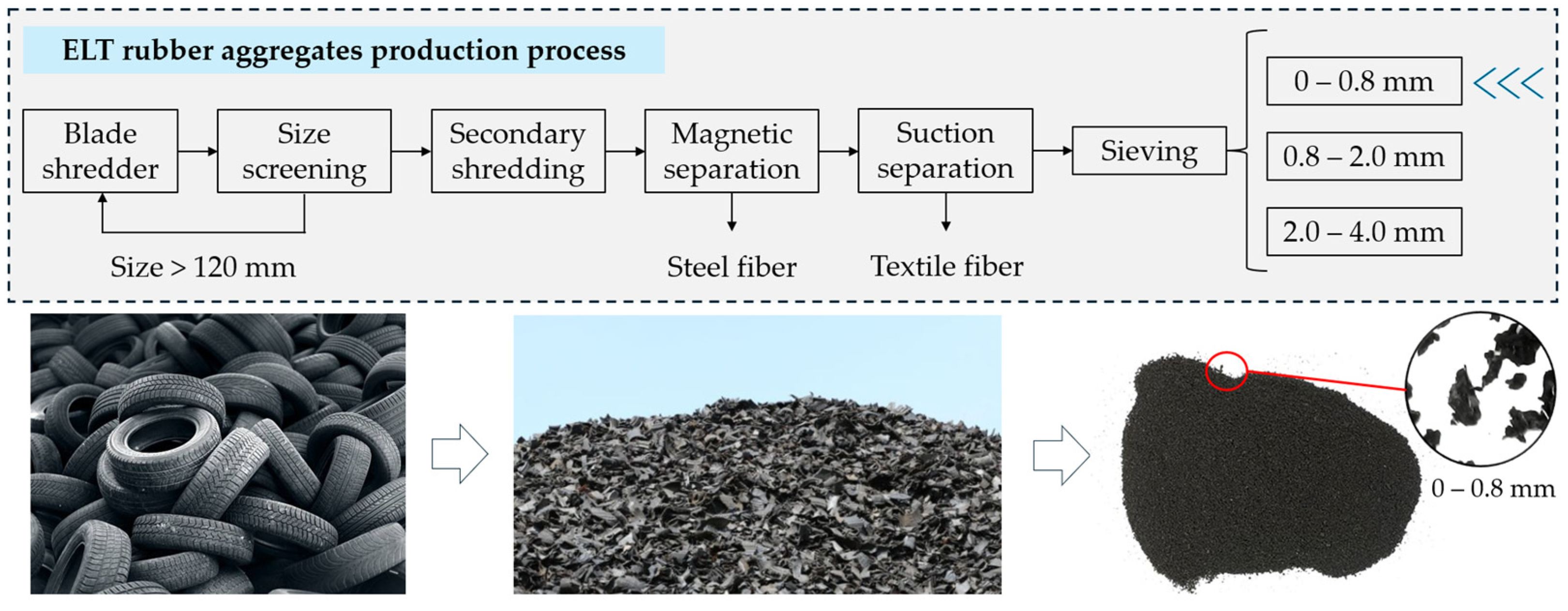

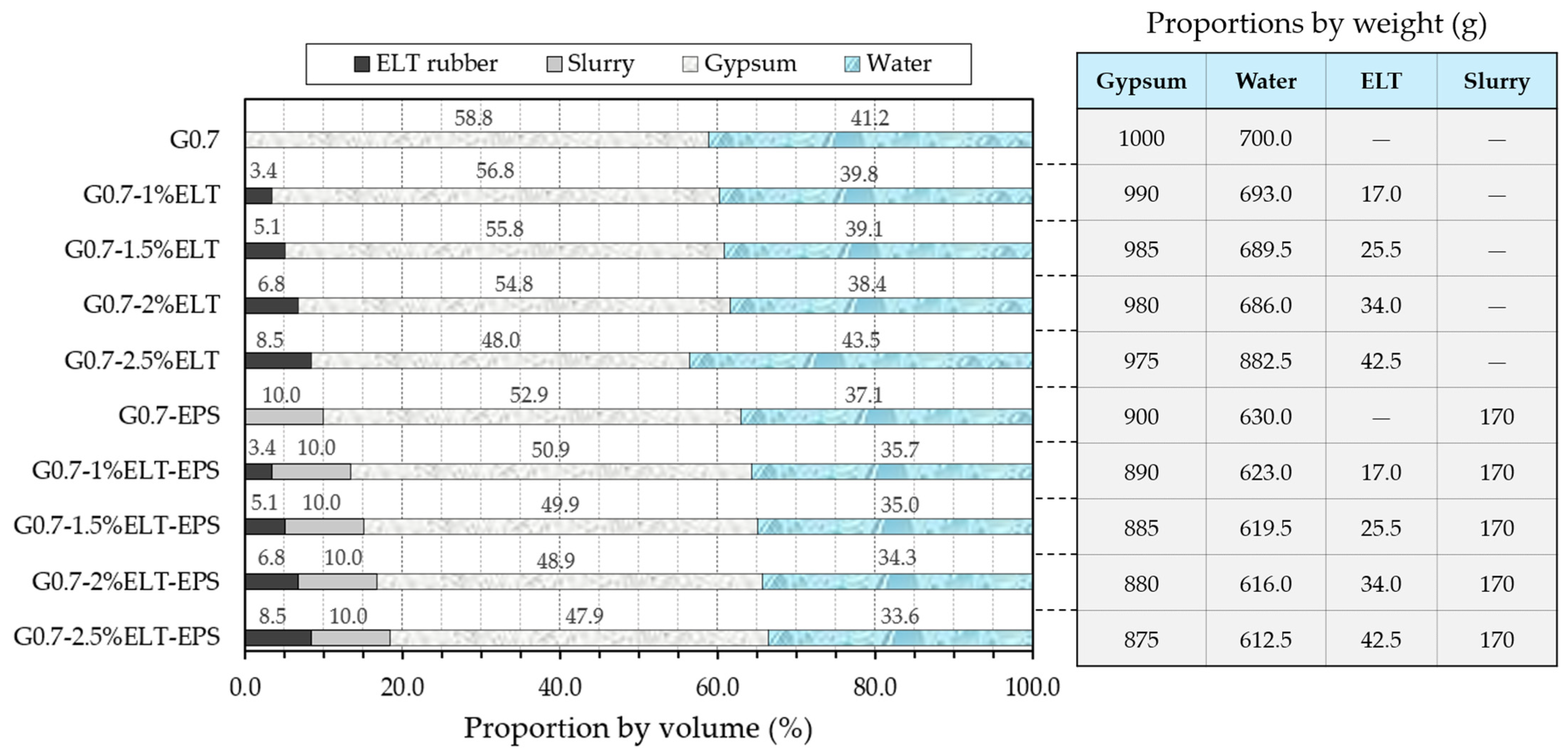



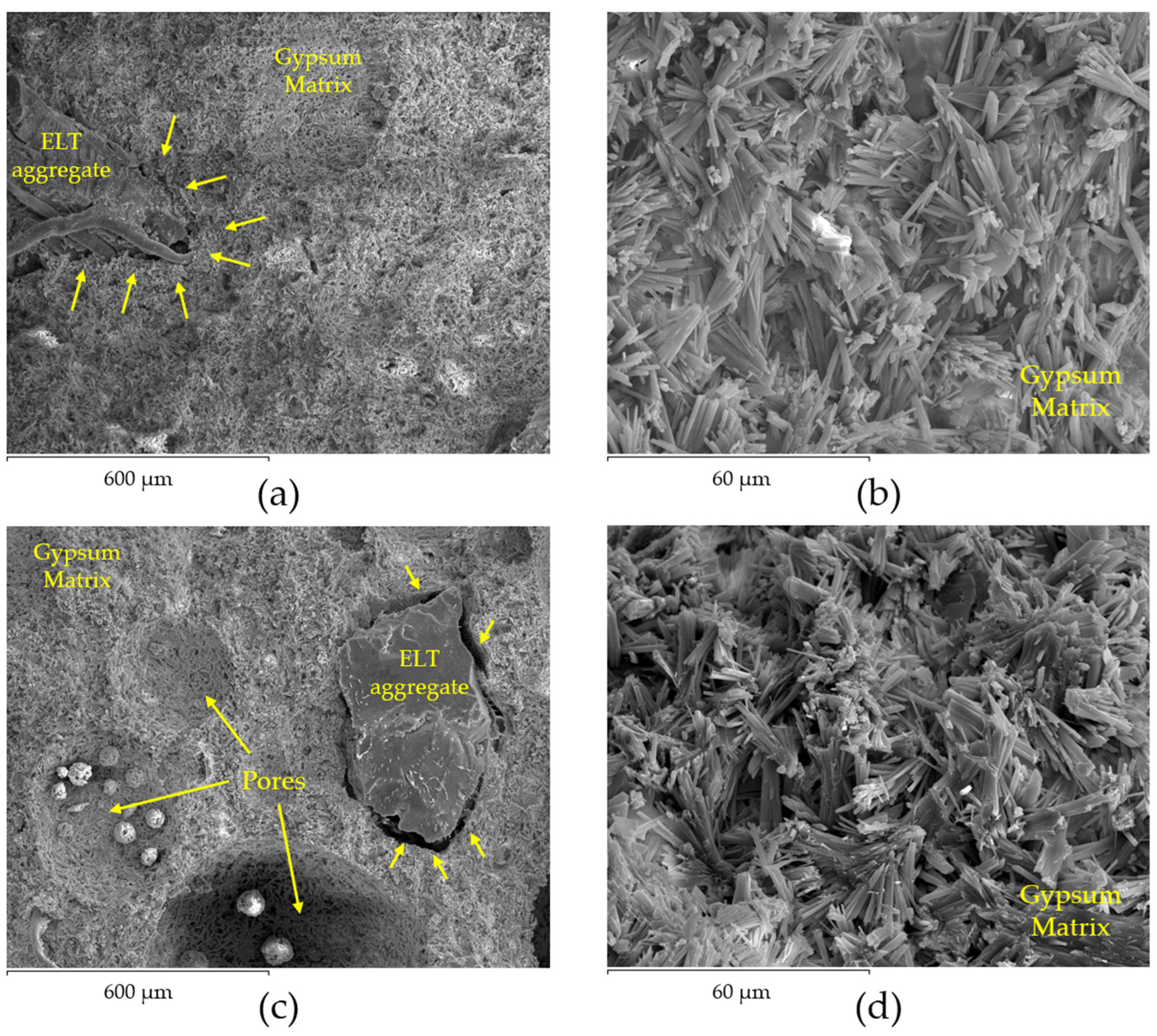
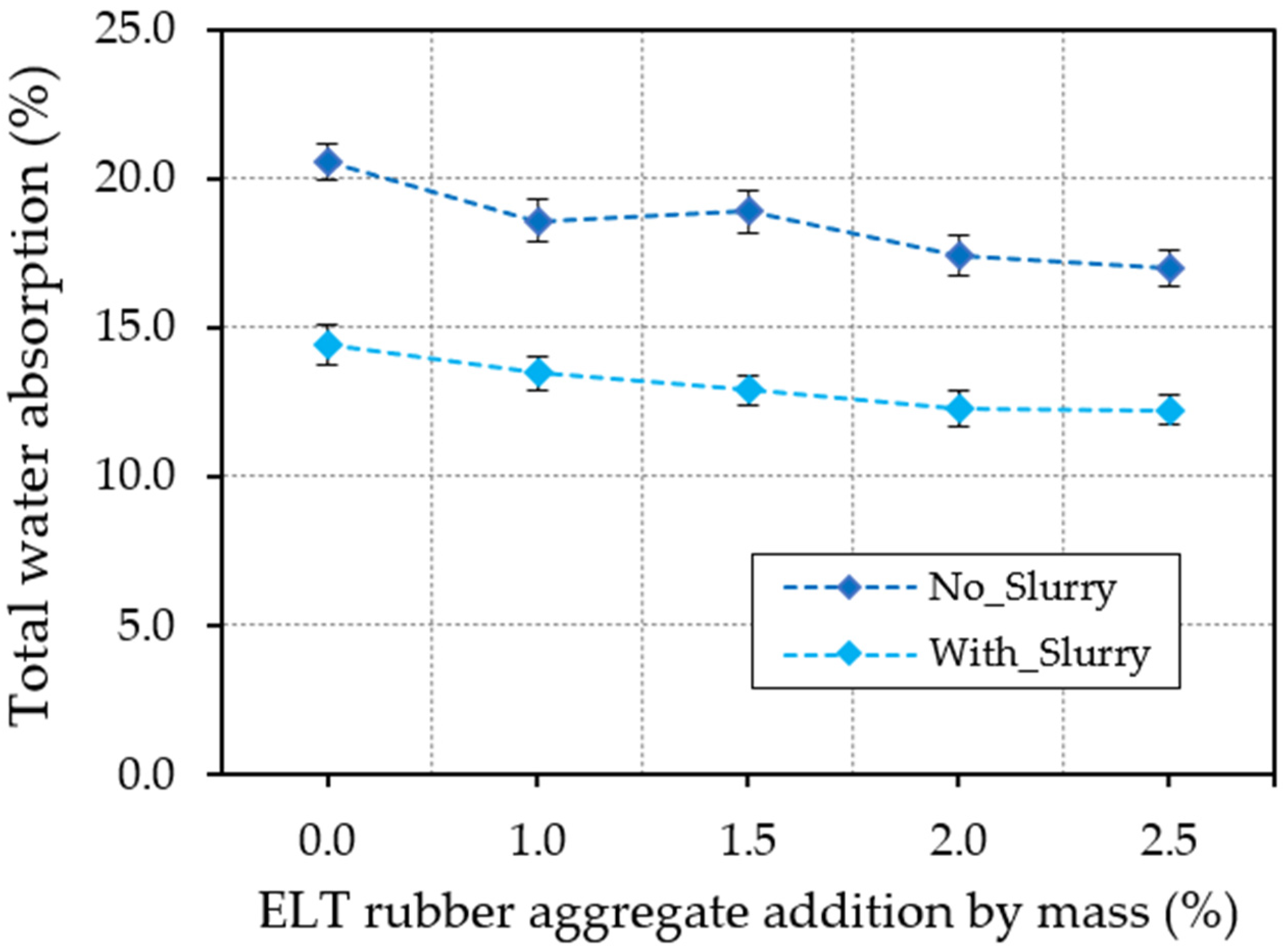
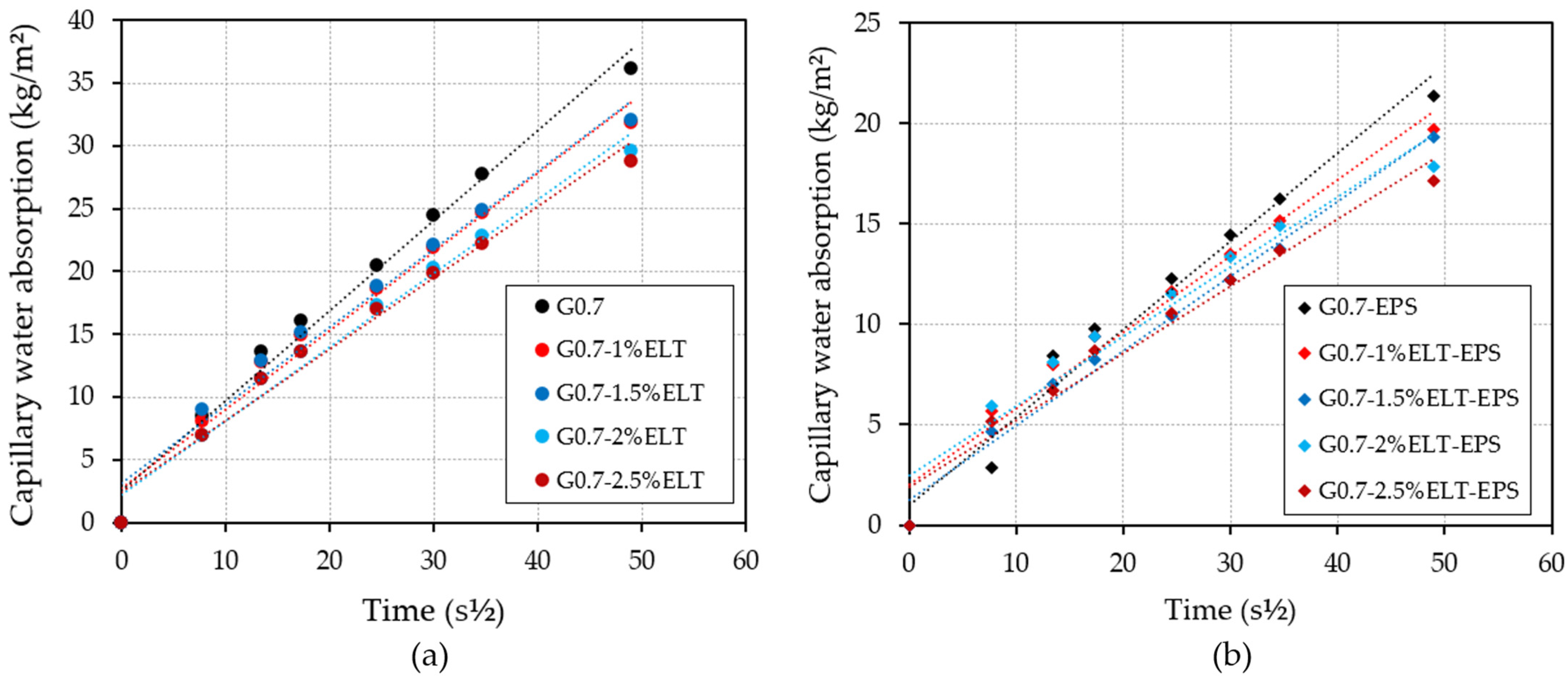
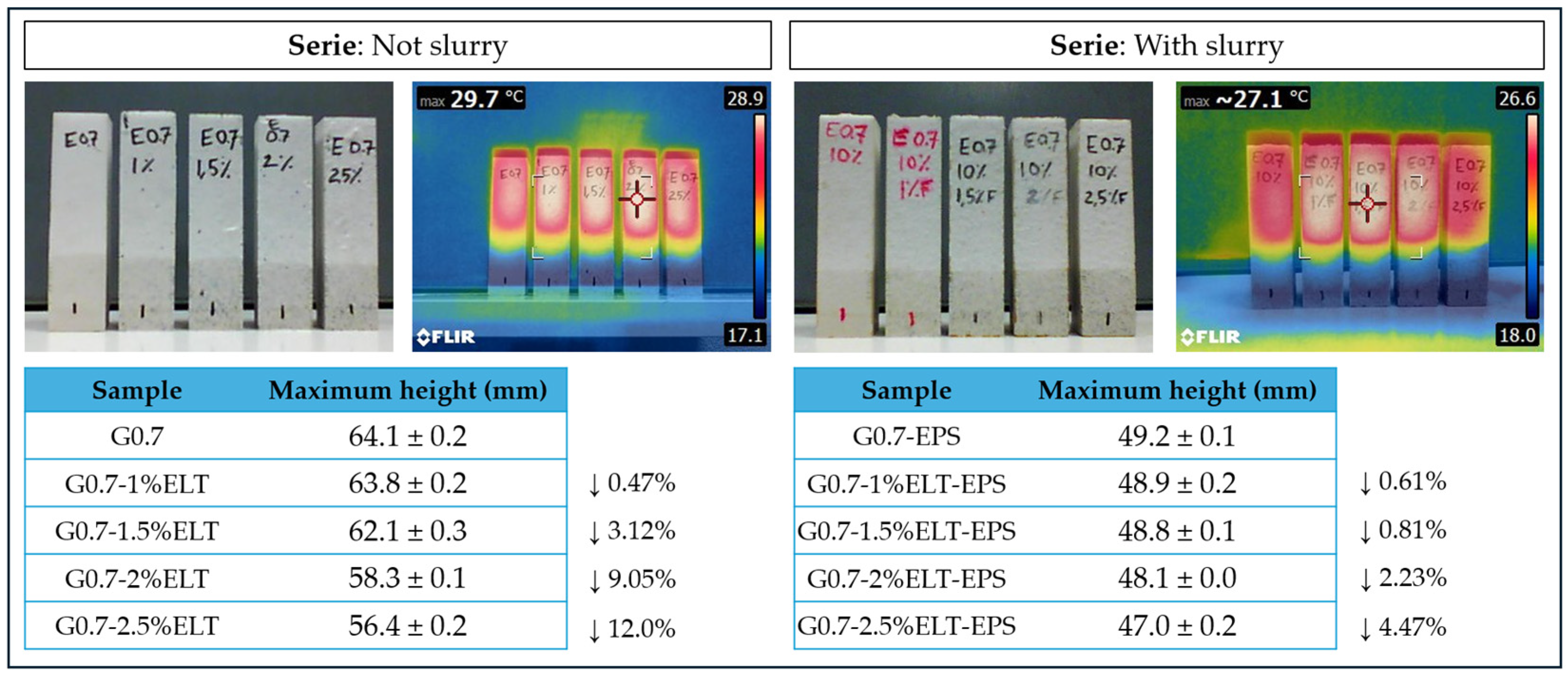



| λ (W/m·K) | pH | Purity (%) | Granulometry (mm) | Setting Time (min) | Fire Reaction (Euroclass) |
|---|---|---|---|---|---|
| 0.30 | 6 | 90–92 | 0.0–0.2 | 15–18 | A1 |
| Series | Equation | R2 | Maximum Value (kg/m2min½) | (%) |
|---|---|---|---|---|
| G0.7 | 0.9864 | 36.2 | - | |
| G0.7-1%ELT | 0.9750 | 32.1 | 11.4 | |
| G0.7-1.5%ELT | 0.9784 | 31.9 | 11.9 | |
| G0.7-2%ELT | 0.9821 | 29.6 | 18.1 | |
| G0.7-2.5%ELT | 0.9778 | 28.8 | 20.6 | |
| G0.7-EPS | 0.9748 | 21.4 | 40.9 | |
| G0.7-1%ELT-EPS | 0.9729 | 19.7 | 45.6 | |
| G0.7-1.5%ELT-EPS | 0.9880 | 19.3 | 46.6 | |
| G0.7-2%ELT-EPS | 0.9466 | 17.9 | 50.6 | |
| G0.7-2.5%ELT-EPS | 0.9659 | 17.1 | 52.7 |
Disclaimer/Publisher’s Note: The statements, opinions and data contained in all publications are solely those of the individual author(s) and contributor(s) and not of MDPI and/or the editor(s). MDPI and/or the editor(s) disclaim responsibility for any injury to people or property resulting from any ideas, methods, instructions or products referred to in the content. |
© 2024 by the authors. Licensee MDPI, Basel, Switzerland. This article is an open access article distributed under the terms and conditions of the Creative Commons Attribution (CC BY) license (https://creativecommons.org/licenses/by/4.0/).
Share and Cite
Zaragoza-Benzal, A.; Ferrández, D.; Barrios, A.M.; Morón, C. Water Resistance Analysis of New Lightweight Gypsum-Based Composites Incorporating Municipal Solid Waste. J. Compos. Sci. 2024, 8, 393. https://doi.org/10.3390/jcs8100393
Zaragoza-Benzal A, Ferrández D, Barrios AM, Morón C. Water Resistance Analysis of New Lightweight Gypsum-Based Composites Incorporating Municipal Solid Waste. Journal of Composites Science. 2024; 8(10):393. https://doi.org/10.3390/jcs8100393
Chicago/Turabian StyleZaragoza-Benzal, Alicia, Daniel Ferrández, Alberto Morón Barrios, and Carlos Morón. 2024. "Water Resistance Analysis of New Lightweight Gypsum-Based Composites Incorporating Municipal Solid Waste" Journal of Composites Science 8, no. 10: 393. https://doi.org/10.3390/jcs8100393
APA StyleZaragoza-Benzal, A., Ferrández, D., Barrios, A. M., & Morón, C. (2024). Water Resistance Analysis of New Lightweight Gypsum-Based Composites Incorporating Municipal Solid Waste. Journal of Composites Science, 8(10), 393. https://doi.org/10.3390/jcs8100393









